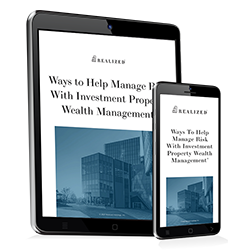
Purchasing an expensive property requires a large cash outlay. This can mean missing out on other potential opportunities and assuming full investment risk.
Real estate investors get around this problem through the use of leverage. Leverage utilizes financing to offset large capital outlays. Instead of using 100% of their capital, an investor may get a loan for 80% of the purchase price, leaving them responsible for the remaining 20%. What is the benefit of using financing to purchase a property?
What Is Leverage?
Leverage is the use of debt financing to purchase an asset. This frees up investor capital for other opportunities and reduces exposure to the investment.
Debt financing usually comes in the form of a loan. This can be from a traditional bank or hard money lender. The goal of leverage is to increase the rate of return.
Is there a difference between real estate leverage and stock market leverage? Yes. When margin, a stock broker’s term for a loan, is used to buy stocks, there are some limitations compared to real estate leverage.
Real estate leverage allows an investor to have a high loan-to-value ratio. An investor can borrow 80% (and sometimes more) of the property’s value. A stockbroker generally allows a loan against a 50% maximum of a stock’s value.
Real estate loans usually have much lower rates than stock broker margin loans. Because of high broker margin loan rates, holding borrowed stocks for the long term is very costly. However, holding real estate property on borrowed funds for years is common practice.
Another major difference between stock and real estate leverage is that stock brokers can issue a margin call at any point. This usually happens when the value of a stock drops below a certain price. But margin levels may adjust at any point, meaning the stock doesn’t have to drop as much before a margin call is issued (due to readjustment by the broker).
A margin call occurs when a stock drops to a specific price level (loan to stock value/position ratio) determined by the broker. The investor must add more funds to the account or sell some shares to get back above the margin call level. Otherwise, the broker has the right to sell shares (at a loss to the investor) to move the account out of a margin call.
A real estate loan is based on a contract and may have specific covenants. Under certain circumstances, your loan can be called. Unlike a broker margin loan, the terms of the loan do not change. The real estate investor is always aware of the condition they may have their loan called. Unfortunately for the stock investor, a broker can adjust the level of required margin on equities. This is fairly common practice when the stock market is volatile.
Some real estate investors find other investors to come into a deal. These investors add funds to the investment. In some cases, an investor may not need a loan. But is this the same as leverage?
When other investors are added to a deal, they take a proportionate share of the equity. These investors are called LPs (i.e., limited partners). The manager of the deal is called the sponsor. Because the LPs are not providing a loan, this is not considered traditional leverage. The sponsor will only receive a return based on the amount of capital the sponsor has in the deal.
Leverage does not use equity. The bank/lender is not participating in any profits from the deal. The lender only receives interest payments.
Use Of Leverage In Real Estate Investing
Let's look at some examples to see how leverage is used in real estate investing.
An investor decides to purchase a $500,000 property. The investor's total capital is $600,000. That leaves only $100,000 for operational expenses or other opportunities. Rather than use 83% of the total capital, the investor acquires a loan for $400,000. Now the investor only needs to come up with $100,000. Instead of 83% of their capital, the investor uses just 16% of total capital.
Investor returns are boosted when the value of a leveraged property increases. For the above example, the value increases by 5%, or $25,000. In the non-leveraged scenario, the investor's return is 5%.
In the leveraged scenario, the return is 25% (25,000/100,000). That’s a 5X return over the non-leveraged scenario.
Why not use leverage all of the time if returns are so great? Returns are largely dependent on the performance of the property. If the property's value doesn't change, the investor will experience a negative return due to operating costs and loan interest.
However, it can get much worse. If the property's value falls by 5%, the leveraged investor will lose far more than 5%. Now the property is worth $475,000, but the investor has lost 25% on their $100,000 investment.
Contemplating different loss scenarios can help determine how much leverage an investor might want to take on. The lower the leverage, the lower the potential loss and, of course, returns. But less leverage is generally more favorable for those who are more risk-averse.
This material is for general information and educational purposes only. Information is based on data gathered from what we believe are reliable sources. It is not guaranteed as to accuracy, does not purport to be complete and is not intended to be used as a primary basis for investment decisions. All real estate investments have the potential to lose value during the life of the investment. All financed real estate investments have the potential for foreclosure. Investing involves risk, including possible loss of principal. A bond's yield, share price and total return change daily and are based on changes in interest rates, market conditions, economic and political news, and the quality and maturity of its investments. In general, bond prices fall when interest rates rise and vice versa. Realized does not provide tax or legal advice. This material is not a substitute for seeking the advice of a qualified professional for your individual situation. Examples shown are hypothetical and for illustrative purposes only.



